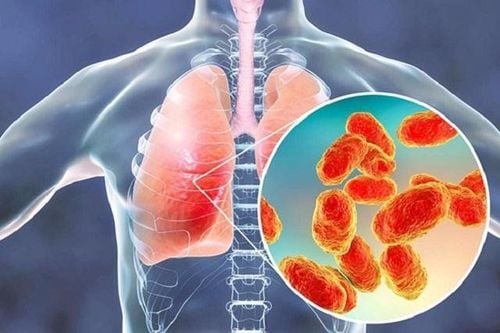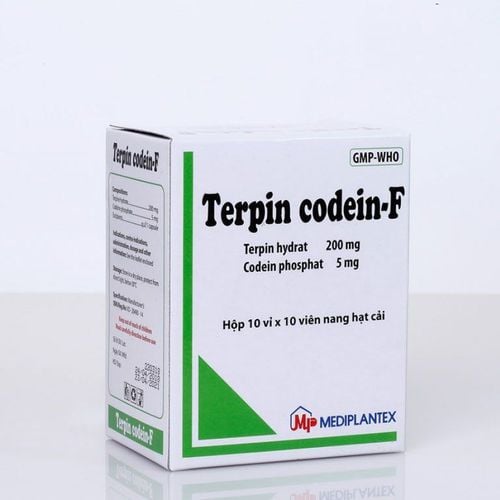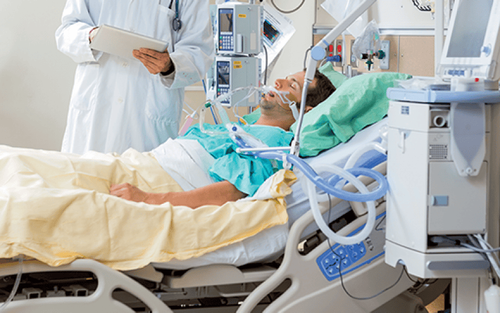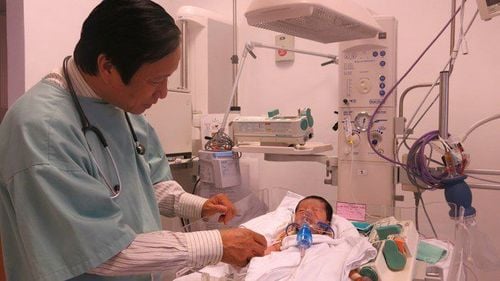This is an automatically translated article.
Article by Master, Doctor Nguyen Ngoc Phu - Department of Intensive Care - Vinmec Times City International Hospital
Mechanical ventilation (mechanical ventilation) can be defined as the technique by which air is moved to and from the lungs through an external device directly connected to the patient... can be performed with negative extrathoracic pressure or intermittent positive pressure.
1. What is the purpose of mechanical ventilation?
The primary purpose of mechanical ventilation is to provide artificial and temporary assistance with ventilation and blood oxygenation
1.1. Physiologically
Adjust and control alveolar ventilation, improve arterial blood oxygenation.
Maintain ventilation to correct and prevent hypercapnia. Blood oxygenation: Increasing FiO2 and/or increasing PEEP prevents atelectasis, reduces shunts, increases functional residual capacity (FRC) and takes advantage of prolongation of gas exchange time. Actively control ventilation when needed such as: Anesthesia for surgical procedures, airway protection and reduction of intracranial pressure (traumatic brain injury, cerebrovascular accident...), bronchoscopy procedures bronchoalveolar lavage (bronchoalveolar lavage, foreign body removal) Reduces lung damage from mechanical ventilation
Reduces metabolic burden by releasing respiratory muscles: respiratory muscles are rested, respiratory muscles are restored.
1.2. Clinically
Solve hypoxia in the blood Solve hyperCO2 in the blood Reduce respiratory failure Prevent and treat atelectasis Solve respiratory muscle fatigue Allow sedation anesthesia => reduce systemic or myocardial oxygen consumption. Chest wall immobilization, airway control and protection

Thở máy giúp ngăn ngừa tình trạng suy hô hấp ở người bệnh
2. What are the indications for mechanical ventilation?
2.1. Alveolar damage
Pneumonia: Infection, virus, aspiration, aspiration... Acute pulmonary edema: Hemodynamic: Cardiac (left heart failure, acute MI), hypertension, volume overload. Non-cardiac (ARDS): Infection (influenza A, B; Sarcovi 2...), inhalation, drowning, blood transfusion, pulmonary contusion, altitude. Pulmonary hemorrhage, lung cancer
2.2. Pulmonary vascular disease
Pulmonary embolism due to thrombosis: Usually due to deep vein thrombosis of the lower extremities moving to the lungs. Amniotic fluid embolism, fat embolism,...
2.3. Airway obstruction
Central airway obstruction Tumor invading large trachea Angioedema Tracheal stenosis Intrathoracic airway obstruction Severe, critical asthma exacerbation Chronic obstructive pulmonary disease
2.4. Decreased alveolar ventilation
Hypoventilation due to CNS depression: General anesthesia, overdose of sedatives Hypoventilation due to neuromuscular disorders: amyotrophic lateral sclerosis, cervical cord injury, Guillance barre syndrome, myasthenia gravis, tetanus, snakebite (scorpion, king tiger), muscle atrophy, poisoning. Hypoventilation due to thoracic and pleural pathology: kyphosis, trauma (movable rib plate), pneumothorax (both drained and mechanically ventilated), large pleural effusion Increased need for ventilation : Septic shock, severe metabolic acidosis

Máy thở được chỉ định trong trường hợp giảm thông do ức chế thần kinh trung ương do quá liều thuốc an thần
3. What are the complications of mechanical ventilation?
3.1. Pressure injury
Occurs when there is excessive lung expansion due to artificial ventilation.
Possible complications:
Pneumothorax. . Needs immediate treatment.
Signaling symptoms are usually anti-aircraft status, airway pressure is increased, oxygen is low, the patient is cyanosis, pneumothorax is detected on auscultation (usually unilateral), or signs of suspected pneumothorax mediastinum (cervical pneumothorax).
This complication can occur if ventilation is given to a patient with too high Vt, or too high airway plateau pressure, especially in patients with air trapping due to bronchial obstruction or small lung conditions. ARDS), especially when PEEP is used.
Prophylaxis: Set appropriate Vt and airflow rate, regularly monitor airway pressures (especially Pplateau) and measure auto-PEEP.
Management: Minimal pleural effusion, emergency ventilation, adjust ventilator parameters appropriately (remove PEEP, reduce Vt, reduce flow rate, reduce frequency), use sedation to control the patient mechanical breathing.
3.2. Acute lung injury
Acute lung injury can occur during artificial ventilation. The cause may also be due to high airway pressure (Pplateau > 30-35 cmH2O), large minute ventilation, high transalveolar pressure, excessive lung expansion, causing damage to the alveolar-capillary membrane.
3.3. Auto PEEP
Patients who are mechanically ventilated with a high Vt and an excessively rapid rate may develop auto-PEEP.3.4. Gas exchange disorder
There may be disturbances in gas exchange and acid-base balance if the parameters of the machine are not set correctly (excessive hyperventilation or hypoventilation).
3.5. Hospital infections
Nosocomial pneumonia due to mechanical ventilation is a common and dangerous complication. Usually caused by multidrug-resistant nosocomial bacteria. The risk of infection is increased if ventilation is invasive (with endotracheal intubation or tracheostomy).
Prophylaxis: Strictly follow the rules of ventilator sterilization, cross-contamination prevention measures in patient care.
Consider ventilator-associated pneumonia when the patient has a fever that occurs 24 to 48 hours after mechanical ventilation. Need to take a chest x-ray and take bronchial fluid to test for bacteria.

Viêm phổi tại bệnh viện là một biến chứng của máy thở
3.6. Collapsed lung
Atelectasis can occur when there is a sputum plug obstructing the bronchial lumen, or because the low tidal volume causes the lungs to expand poorly. There may be 1 lobe, 1 segment, or micro atelectasis. Atelectasis worsens respiratory failure by disrupting the ventilation/perfusion ratio (increased shunt effect).
Prevention:
Ensure airway clearance, avoid sputum congestion.
Use PEEP if no contraindication (PEEP = 5 cmH2O), or artificial ventilation with high Vt.
3.7. Complications due to endotracheal tube, tracheostomy
The endotracheal tube enters one side of the bronchus (usually the right side), damage to the larynx, trachea, tube blockage due to swallowing sputum, slip of the endotracheal tube,...
3.8. Some other complications
Cardiovascular effects: Decreased cardiac output, hypotension (especially with high PEEP or high tidal volume). Renal-urinary disorders: Decreased renal perfusion, increased secretion of ADH, inhibition of atrial Na-secreting factor - resulting in decreased water purification, causing generalized fluid retention. Digestive disorders: Abdominal distention, intestinal paralysis, constipation due to lying down for a long time; peptic ulcer due to stress, gastrointestinal bleeding due to stress. Increased intracranial pressure with PEEP. Psychosis.
Please dial HOTLINE for more information or register for an appointment HERE. Download MyVinmec app to make appointments faster and to manage your bookings easily.













